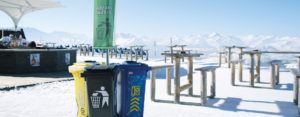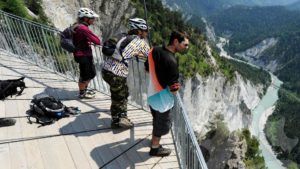The world’s first self-sufficient winter resort: Skiing in the heat

Climate change pushes Weisse Arena Gruppe to aim high
Swiss-based Weisse Arena Gruppe is struggling with the consequences of climate change similarly to many other ski resorts all over the world and during 2015/16 reported its first net loss in history at CHF 1.1 million at revenue of CHF 89.9 million [1]. How do they recover?
Weisse Arena is an integrated service company operating the cable cars and lifts in the area as well as surrounding businesses, such as hotel, gastronomy and equipment rental. Under the brand of Laax it runs one of the larger and higher ski areas in Switzerland with 235km of slopes at an average altitude of 2060m above sea level [2] and is a major employer within the canton of Graubünden providing work for over 1000 people during the winter months [3].
Since the end of the 19th century average temperatures in Switzerland have increased by more than 2°C with a particularly notable increase since the 1980s (see graph) [4]. Feeling this impact directly, rain up to an altitude of 2000m caused a drop in visitors to Laax to 846,451 guests in 2015/16, a decrease of 5.4% from the year before and 21.6% relative to the record year 2002/03 [5]. Previously, in 2014 the operator had asked locals to remain home in order to allow tourists to enjoy the little snow left [6].
Temperature difference from norm 1961 to 1990
Lofty Goals: Stepping forward
Despite this poor performance, Weisse Arena did not come unprepared. To date 35km [7] of slopes are permanently equipped with snow cannons. This required overcoming Graubünden government regulation from 1990 allowing coverage of maximum 5% of resort area with artificial snow [8] as locals feared the cannon’s energy consumption. Only as worries about the areas major employer surfaced and energy needs could be met increasingly by renewable sources did the regulation get lifted.
In fact, this environmental focus has led to lofty goals: The Group’s vision is to become “the world’s first self-sufficient winter resort” [9]. Today, 100% of the resorts energy needs are covered by CO2 neutral energy from Swiss hydro plants (~75%) and the resort’s own solar panels (~25%) [10] [11]. Furthermore, a wind farm project will bring renewable energy to 5,000 households in the region. Renewed lifts (such as 2015s La Siala chairlift) reduced energy consumption by 5%.
Furthermore, Laax aims at a zero waste policy having implemented a functional recycling system and reduced waste through the KeepCups initiative [12]. Sourcing local, eco and Fairtrade ingredients for the gastronomy is another step towards reducing Laax’ ecologic impact [13].
However, pressures remain high. The resort continues to invest in its summer infrastructure attracting hikers and other outdoor tourists (increasing share of summer guests from 7 to 11% since 2002) [14], and discounts encourage winter tourists to buy tickets months in advance in order to smooth revenue. However, still 95% percent of revenue is generated during the winter season and discounts have a direct impact on the top line. Furthermore, improving conditions through artificial snow coverage (with estimated costs CHF 1 million per km) [15] and making slope adjustments as well as active snow management remain expensive. And global warming is predicted to continue…
What’s next?
So what can be done? US ski resorts such as Washington School House have invested more aggressively in diversifying their offer through theme parks, spa offerings and introducing new outdoor activities [16]. This will also increase average revenue per guest. Whilst Weisse Arena was already able to increase average spending from CHF 93 to 106 over the last four years, this will be a trend likely to continue as servicing the resort will become more cost intensive [17]. Additionally, Weisse Arena will have to become more considerate in how it expands its network. In particular, this means shifting lifts and slopes to higher altitudes. In order to reduce personal and energy costs the company will need to focus on improving utilization of lifts and slopes, closing some of them temporarily when few people are on the mountain.
Another, albeit ambitious, initiative may be to shift the main ski season altogether. Most German states do not have a week of “ski holidays” for schools in February when conditions are best, restricting families to coming over Christmas and New Years and hence before snow coverage has reached its maximum. Such a movement however will most likely only succeed when even the highest ski resorts in the Alps will fully experience the impacts of global warming.
Until then the solution remains to invest in artificial snow and alternative attractions, and hoping that the rest of the world starts taking its eco-footprint as seriously as the Weisse Arena Gruppe. Happy skiing!
(792 words)
Footnotes
[1] Weisse Arena Gruppe. 2016. Geschäftsbericht 2015/2016. [ONLINE] Available at: http://www.weissearena.com/fileadmin/user_upload/pdf/Geschaeftsberichte/Geschaeftsbericht_2015-2016.pdf. [Accessed 4 November 2016].
[2] Qualität GR. 2013. Macht der Klimawandel Graubünden zum Alpenresort für Wintersportler?. [ONLINE] Available at: http://www.qualitaet-gr.ch/uploads/files/BT_Klimabericht_310813.pdf. [Accessed 4 November 2016].
[3] Weisse Arena Gruppe. 2015. Company Portrait. [ONLINE] Available at: http://www.weissearena.ch/en/company/portrait/. [Accessed 4 November 2016].
[4] see [2]
[5] see [1]
[6] vzsb. 2015. Der gekaufte Winter. [ONLINE] Available at: http://www.vzsb.de/media/docs/Der_gekaufte_Winter_-_8.12.2015.pdf. [Accessed 4 November 2016].
[7] see [3]
[8] see [2]
[9] Laax.com. 2016. Greenstyle. [ONLINE] Available at: https://www.laax.com/en/experience-resort/greenstyle. [Accessed 4 November 2016].
[10] Laax.com. 2016. Energy. [ONLINE] Available at: https://www.laax.com/en/experience-resort/greenstyle/energy. [Accessed 4 November 2016].
[11] Das Lamm. 2016. Laax serviert Mediterrane Sünden. [ONLINE] Available at: https://daslamm.ch/laax-serviert-mediterrane-sunden-3000-meter-uber-meer/. [Accessed 4 November 2016].
[12] Laax.com. 2016. Zero Waste – Recycling. [ONLINE] Available at: https://www.laax.com/en/experience-resort/greenstyle/recycling. [Accessed 4 November 2016].
[13] Laax.com. 2016. Water Food Purchasing. [ONLINE] Available at: https://www.laax.com/en/experience-resort/greenstyle/water-food-purchasing. [Accessed 4 November 2016]
[14] see [1]
[15] see [5]
[16] Hotel Executive. 2016. Diversification is Key for Ski Resorts. [ONLINE] Available at: http://hotelexecutive.com/business_review/4317/diversification-is-the-key-for-ski-resort-hotels. [Accessed 4 November 2016].
[17] see [1]
Images
http://www.qualitaet-gr.ch/uploads/files/BT_Klimabericht_310813.pdf
https://www.laax.com/en/experience-resort/greenstyle/recycling
http://rancho-laax.ch/new/wp-content/uploads/Erleben/Wandern/Conn/norm05.jpg






My biggest concern is what impact does artificial snow or “skiing in the summer” have on the overall consumer experience at these resorts as compared to the “traditional ski experience?” While the revenues/guest seem to be rising in the short term, I wonder if there is an approaching tipping point at while the “new” experience will drive families to more just pay more for traditional mountains or away from a ski vacation all together. Perhaps, these new hybrid resorts will no longer be competing with the traditional ski mountains and instead will move towards a more Disneyland like offering where “skiing” is just one of the experiences offered as opposed to the main revenue driver of the mountain. The ski industry (and all winter actives resorts) will certainly continue to feel the pressures of climate change over the coming years, so it will be interesting to see the strategic responses.
If the resort continues to increase prices due to increased operating costs, effectively passing along the costs onto customers, how will the resort compete with others who find ways to contain their operating costs? Especially if there are other resorts that are positioned on higher elevation and are impacted less severely then Weisse Arena Gruppe resorts. One thing this resort should consider is how to improve profit margins on the non-skiing activities in order to maintain its pricing structure for its main attraction, skiing.
Even if the resort is able to produce enough artificial now, I am concerned that customer demand will still decrease. I think that consumers are somewhat triggered to go skiing after a fresh snow fall. If it is warm outside and hasn’t snowed in a while, potential customers are not primed to think about skiing.
When I previously looked at potential investments in skiing resort owner/operators, the biggest issues to me is the capacity utilization of the asset – most of the resorts are open from Nov to Feb, only four months of a year. This is largely due to the underdevelopment of other tourism facilities in that resort, which limited consumers willingness to visit outside of the skiing season. What Weisse Arena Gruppe is doing on energy conservation is impressive, but from a business standpoint, I believe that trying to improve their resort facilities and develop new tourism activities (i.e. hiking for the summer, weekend family getaways all the year round) would be an easier, quicker and more profitable approach.
Laax is clearly facing challenges in the years ahead with temperatures forecasted to keep rising. The initiatives undertaken to date (recycling and CO2 neutral energy) signal good intent on behalf of the Weisse Grupe but will not be enough to reverse the challenges of climate change. For me, the only long term solution to protect the ski area is to expand upwards, as you mention, and to move the main skiing holidays to earlier in the year. Unfortunately these initiatives feel unsatisfactory in preserving the long term future of the resort and I fear Laax, along with many other lower resorts, face a very tough future unless they can find a way to make and maintain much more snow than they are currently able.